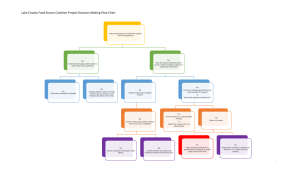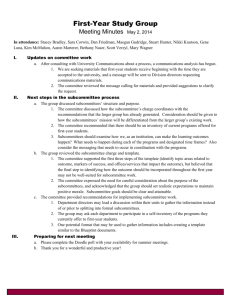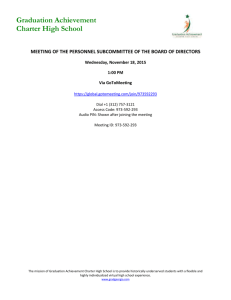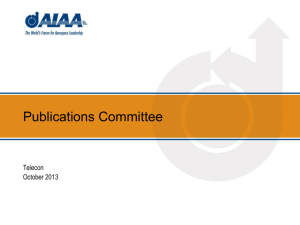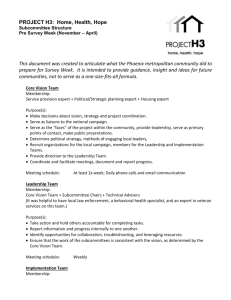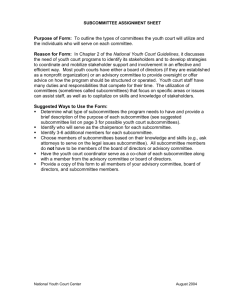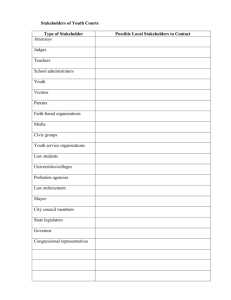FACE_Org_Chart_Subcommittee_Charters_v1.1_5Dec2013
advertisement
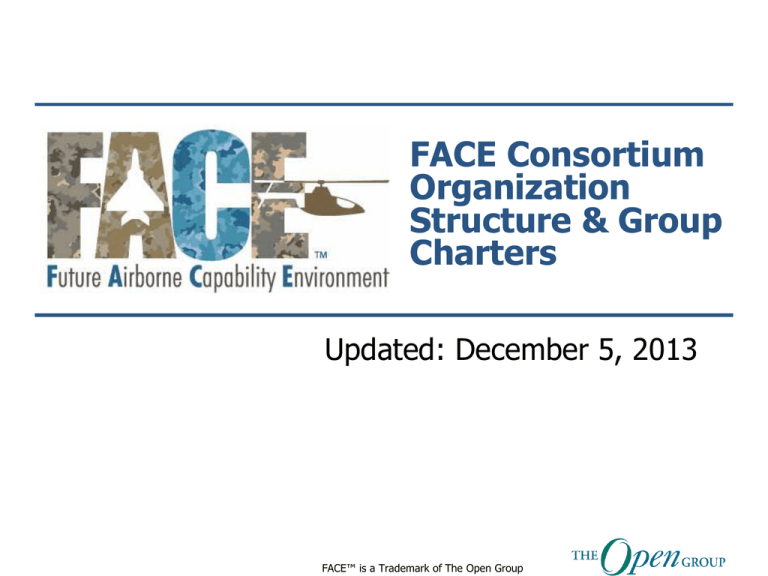
FACE Consortium Organization Structure & Group Charters Updated: December 5, 2013 FACE™ is a Trademark of The Open Group The FACE Consortium Org Chart 2 FACE Consortium High-Level Charters • • • • • • 3 Technical Working Group (TWG): The charter of the FACE Technical Working Group (TWG) is to identify open standards where such exist, define standards that do not yet exist, and provide guidance for using these standards to achieve portability of software-based capabilities across multiple avionics platforms. - The TWG is technical body responsible for all FACE Consortium technical aspects. The TWG defines the Technical Standard for the FACE Reference Architecture, provides guidance supporting the standard, develops additional support documentation, provides implementation guidance, and defines procedures for FACE Conformance. Business Working Group (BWG): The charter of the FACE Business Working Group (BWG) is to Develop, Implement and Communicate Attractive Industry-Government Business Models that Incorporate the FACE Vision and Mission. - The BWG defines business models to communicate FACE Consortium goals to DoD and Industry leaders and promotes the use of the FACE approach in avionics developments, procurements and upgrades. They also establish requirements for the Library of FACE conformant products and defines the policies for FACE Conformance. Enterprise Architecture (EA) Team: The charter of the EA Team is to Define and develop formal architecture products (artifacts) to create clear, top-level picture of the FACE Enterprise for a wide variety of Consortium and outside audiences, address the FACE role in the context of related initiatives and programs, and ensure internal consistency across the FACE Business and Technical architecture. FACE UCS Alignment Liaison: The charter of the FACE UCS Alignment Liaison is to participate in both UCS and FACE meetings, and report on areas where working groups can align and are collaborating to leverage each others’ business and technical products. Advisory Board: The charter of the Advisory Board is to provide guidance and advice to the consortium. Subcommittees: The Subcommittees develop specific content and deliverables as directed by Business and Technical Working Groups. FACE BWG Org Chart Business Working Group FACE / UCS Alignment Bill Antypas (NAVAIR) Business Model Subcommittee Gabriel Flores (Northrop Grumman) 4 Chair: Dennis Stevens (Lockheed Martin) Vice Chair: David Boyett (US Army AMRDEC) Conformance Subcommittee Steve Goetz (US Army AMRDEC) Library Subcommittee David Boyett (US Army AMRDEC) Enterprise Architecture Steve Davidson (Raytheon) Outreach Subcommittee Chip Downing (Wind River) FACE BWG Subcommittee Charters BWG Subcommittees: • Business Model (BMS): The charter of the BMS is to evaluate, develop, and disseminate business models that will support the successful development, delivery, maintenance and conformance of components and systems to the FACE Technical Standard. The scope of the BMS effort includes the examination of requirements for, and subsequent modeling of, government to government, government to contractor, and contractor to contractor interactions in the execution of contractual obligations utilizing the FACE environment. The BMS shall use all available resources within Government, Industry and Academia to accomplish these stated goals. • Conformance: The charter of the Conformance Subcommittee is to develop the FACE Conformance Program which will include a set of plans, procedures, and certification environments, with roles and responsibilities for participants, to Certify the Software Products that have applied for FACE Conformance Certification • Library: The charter of the FACE Library Subcommittee is to define the operational, functional, and physical requirements for identification, storage, management, and distribution of FACE conformant products, and develop a plan to enable the FACE Consortium to implement these requirements. • Outreach: The charter of the Outreach Subcommittee is to promote the uptake and support of the FACE approach and the FACE Consortium by developing and coordinating messaging, outreach efforts, and events. 5 FACE TWG Org Chart TECHNICAL WORKING GROUP Chair: Robert Sweeney (NAVAIR) Vice Chair: Kirk Avery (Lockheed Martin) Standards Subcommittee (Robert Sweeney/ Kirk Avery/David Bowes) • • • • Data Model (Jeff Hegedus/Bill Kinahan) Airworthiness Guidance (George Romanski/Glenn Carter) 6 EA Support (Kirk Avery/Jeff Hegedus/Robert Sweeney) Edition 1.0 Revisions Edition 2.1 Revisions Edition 3.0 Revisions FACE Introduction Configuration (Joel Sherrill/Joe Dusio) BWG Support (Robert Sweeney/Kirk Avery/Dr. Bubba Davis/Marcell Padilla) Reference Implementation Guide (Kirk Avery/David Bowes) General Enhancement (Robert Sweeney/Brett Caspers • Conformance • Library Conformance Verification Matrix (Dr. Bubba Davis/Marcell Padilla) Transport (Kirk Avery/Bill Antypas) Graphics (Paul Jennings/Levi Van Oort) Security (Joe Neal/Scott Wigginton) FACE TWG Subcommittee Charters TWG Subcommittees: • Data Model and Data Definition: The charter of the Data Model Subcommittee is to define configuration data, messages and requirements for transient and persistent data models and meta data in the FACE architecture, guided by existing standards and methodologies. • Reference Implementation: The charter of the Reference Implementation Subcommittee is to produce a FACE Reference Implementation Guide providing implementation and integration guidance and development scenarios. • Security Team (ST): The charter of ST is to focus on security specific considerations associated with avionics systems and software. The subcommittee is tasked with providing security specific input for the FACE Technical Standard and Implementation Guide as well as reviewing other sections of these documents for consistency and content relative to security. The ST is encouraged to participate in all FACE technical subcommittee and wider team activities and provide feedback, guidance and recommendations on the security impacts or challenges posed. The ST will be ITAR compliant. The FACE Technical Standard and Implementation Guide will remain public distribution documents; the FACE ST will capture any restricted information in separate appendices. 7 FACE TWG Subcommittee Charters TWG Subcommittees, Cont’d: • Verification Matrix: The charter of the Verification Matrix Subcommittee is to analyze the requirements of the FACE standard and develop a Conformance Verification Matrix for each edition of the FACE Technical Standard. The matrix is intended to identify methods and artifacts needed for FACE conformance verification. This subcommittee will also publish a Matrix User's Guide for use by Verification Authorities (VAs) as well as software suppliers. This subcommittee will provide recommendations for Conformance Test Suite requirements. • Transport: The charter of the FACE Transport Subcommittee is to consider modifications to the Transport Services Segment (TSS) sections of the FACE Technical Standard and other Technical Working Group (TWG) work products. The subcommittee will harmonize with the Configuration, Data Model, and Health Monitoring/Fault Management (currently inactive) subcommittees to eliminate inconsistencies inhibiting implementation. • Configuration: The charter of the Configuration Subcommittee is to identify, scope, and document the required configuration capabilities and how they relate to each FACE profile and segment. Given these capabilities, identify and document configuration interfaces and activities as well as any impact on the FACE architecture. – 8 Tagline: “Portable Configuration for Portable Components” FACE TWG Subcommittee Charters TWG Subcommittees, Cont’d: • Software Safety: The charter of the Software Safety Subcommittee is to produce the guidance document associated with software development process and production of airworthy software using the FACE standard. • Graphics: The charter of the Graphics Subcommittee is to provide a definition of graphical services and guidance on their implementation, utilizing guidance from existing standards and methodologies. • General Enhancement: The charter of the General Enhancement Subcommittee is to be responsible for modification of the FACE Technical Standard for all changes that will touch more than one segment or subcommittees. The subcommittee coordinates changes between multiple subcommittees and is responsible for enhancements and modifications that are not addressed by the specialized subcommittees. • Health Monitoring Fault Management (HMFM - currently inactive): The charter of the HMFM Subcommittee is to scope, identify and capture the required HMFM capabilities and how they relate to each FACE profile. Given these capabilities, they identify and document HMFM interfaces, associated data modeling and impact of HMFM on the FACE architecture at large. 9
